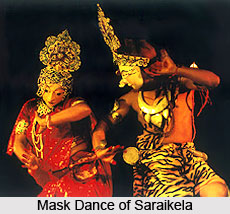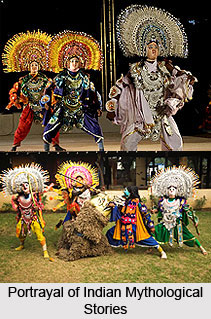 Saraikela Chhau is a masked dance from the Saraikela region of the present state of Jharkhand. It is about 30 miles from the steel town of Jamshedpur or Tatanagar. In Chhau dance of Saraikela there is complete absence of Vachikabhinaya by means of vocal support and Mukhabhinaya, as the face is completely concealed by the mask. The emoting is done kinesthetically through body movements. The elements of speech are also absent here.
Saraikela Chhau is a masked dance from the Saraikela region of the present state of Jharkhand. It is about 30 miles from the steel town of Jamshedpur or Tatanagar. In Chhau dance of Saraikela there is complete absence of Vachikabhinaya by means of vocal support and Mukhabhinaya, as the face is completely concealed by the mask. The emoting is done kinesthetically through body movements. The elements of speech are also absent here.
Mask is the centre of attraction. There is greater scope for expression through mime and body language. Different Bhavas (Moods) and Rasas (sentiments) are expressed through the movements of the limbs in Chhau. The Seraikela Chhau has evolved from a distinct martial art called "Pharikhanda" play of (sword and shield) and has a few distinguished manners of execution. The mask covers the face exerting the dancers to express his Bhava (Mood) and Rasa (sentiments) through body movements like Siro Bhedo (Head gesture) and Griba Bhedo (neck gesture) leaving no room for "Dristi Bhedo" (eye movements and glances). The Seraikella masks are similar to those used in the Noh dance of Japan and the Wayang Wong of Java.
Saraikela Chhau is symbolic, realistic in character. Saraikela Chhau dance is comparatively less thematic. In Saraikela, the Sun-festival or Chaitra Parva that is observed by the Maharaja`s family. The rituals associated with it are observed in full detail. The Chhau dance in Saraikela is ceremonially performed on this occasion.
In Saraikela and Mayurbhanj, a form of physical exercise known as Parikhanda of the warriors employed by the Maharajas that has been integrated into the practice of the local form of Chhau dance. This has given a vigorous character to the dance. Parikhanda usually started after the Durga Puja in the autumn and originally it had nothing to do with Chaitra Parva held in April.
 In Seraikella Chhau dance is more liberal. In Seraikella the children also have their Chhau dance and that is very simple and performed without masks. Other forms are performed by the adult male dancers on the items composed by individuals without any dramatic theme but on a secular mood. Arati dances, fishermen`s dance, sword dance, and hunters` dance come under this head. The third form of Chhau dance is a symbolic dance. Peacock dance symbolizes some very intricate feelings of human mind. In Seraikella the realistic form and character has been discarded that has developed into the most significant symbol of life and beauty. In Seraikella the peacock dance is interpreted as pride in man represented by a bird. The deer dance is interpreted as `the fright of human beings when beset with difficulties`. The dance of the boatman and his wife is interpreted as the practical difficulties in a conjugal life. Repertoire of Seraikella Chhau includes historical events and topical items sometimes representing national sentiments like Vande mataram. The historical and topical items came to the limelight in Seraikella. In Seraikella, only the following mythological items were part of the repertoire: Ardha-Nariswar, Baka-sura or the demon Baka, Dasa Mahavidya, breaking of the thigh of Duryodhana, Draupadi Vastraharan, Gada Yuddha, Hara-Parvati, Hara-Visnu, Kaliya Damana, the snake, Kacha and Devayani, Kali, Kartikeya, Madhu-Kaitabh, Ma-hishasura-Vadha or killing of the buffalo demon, Parasurama (Ramayana), Rishyasringa (Ramayana) Siva (Siva Purana), Samudra-sasan or controlling the ocean (Ramayana), Vasuki and Garuda, Yirya-sulka, or capture (of bride) by valour (Mahabharata). Due to a symbolic character, the mask used in Seraikella does not have many varieties. They are simple objects of art. There are neither decorations nor any complications as they serve a different purpose from that of Purulia. These masks have been made there with the purpose to give scope to such movements. Due to the simple nature of the masks used in Seraikella, such movements are not possible there and the technique of the dance there has developed ignoring this aspect of the masks.
In Seraikella Chhau dance is more liberal. In Seraikella the children also have their Chhau dance and that is very simple and performed without masks. Other forms are performed by the adult male dancers on the items composed by individuals without any dramatic theme but on a secular mood. Arati dances, fishermen`s dance, sword dance, and hunters` dance come under this head. The third form of Chhau dance is a symbolic dance. Peacock dance symbolizes some very intricate feelings of human mind. In Seraikella the realistic form and character has been discarded that has developed into the most significant symbol of life and beauty. In Seraikella the peacock dance is interpreted as pride in man represented by a bird. The deer dance is interpreted as `the fright of human beings when beset with difficulties`. The dance of the boatman and his wife is interpreted as the practical difficulties in a conjugal life. Repertoire of Seraikella Chhau includes historical events and topical items sometimes representing national sentiments like Vande mataram. The historical and topical items came to the limelight in Seraikella. In Seraikella, only the following mythological items were part of the repertoire: Ardha-Nariswar, Baka-sura or the demon Baka, Dasa Mahavidya, breaking of the thigh of Duryodhana, Draupadi Vastraharan, Gada Yuddha, Hara-Parvati, Hara-Visnu, Kaliya Damana, the snake, Kacha and Devayani, Kali, Kartikeya, Madhu-Kaitabh, Ma-hishasura-Vadha or killing of the buffalo demon, Parasurama (Ramayana), Rishyasringa (Ramayana) Siva (Siva Purana), Samudra-sasan or controlling the ocean (Ramayana), Vasuki and Garuda, Yirya-sulka, or capture (of bride) by valour (Mahabharata). Due to a symbolic character, the mask used in Seraikella does not have many varieties. They are simple objects of art. There are neither decorations nor any complications as they serve a different purpose from that of Purulia. These masks have been made there with the purpose to give scope to such movements. Due to the simple nature of the masks used in Seraikella, such movements are not possible there and the technique of the dance there has developed ignoring this aspect of the masks.



















